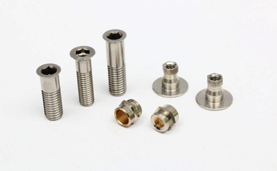Summary:Forging is a common forging processing method. It refers to a workpiece or blank obtained by forging...
Forging is a common forging processing method. It refers to a workpiece or blank obtained by forging a metal blank and deforming it. The metal blank is subjected to pressure to produce plastic deformation and change its mechanical properties. So what is the heat treatment process of forgings? Next,
Brishine United Industry Co., Limited. will introduce you to the following ways.

1. Reasonable selection of deformation temperature and deformation speed
Reasonable selection of deformation temperature and deformation speed during deformation to ensure that the metal has good plasticity during forming is very important for plastic forming. If the deformation temperature is too high, it is easy to overheat the deformed metal and cause coarse grains. If the temperature is too low, work hardening will occur when the metal is deformed, which will increase the deformation resistance, reduce the plasticity of the forging metal, and cause deformation and cracking in severe cases. For materials with high deformation speed sensitivity, the deformation speed should be selected reasonably. Generally speaking, the deformation speed of hammer equipment is the highest, the deformation speed of hydraulic press is the lowest, and the deformation speed of press is somewhere in between. For example, magnesium alloy forging is suitable for forging on a press. If forging on a hammer, it is best to tap lightly at the beginning, and gradually increase the degree of deformation during each hammer forging as the groove is filled.
2. Reasonable choice of deformation method
The choice of deformation method directly affects the plastic flow and stress state of the deformable body in the cavity. For example, the more the number of compressive stresses the blank bears during deformation, the better its plasticity. Therefore, for materials with low plasticity during plastic deformation, some measures can be used to increase the three-directional compressive stress state and prevent the blank from cracking. For example, when upsetting, a movable collar or a sheath can be used to facilitate the forming, and the use of an anvil for drawing is beneficial to the forming and improves the efficiency of drawing.
3. Improve the uniformity of material composition and organization
The chemical composition and structural properties of the alloy ingot are very uneven. High temperature diffusion annealing can be carried out before plastic processing to make the structure and composition of the ingot uniform and improve the plasticity of the material. For example, magnesium alloy MA3 undergoes high temperature homogenization treatment at 400℃ for 10 hours, and the compression deformation on the press can reach more than 75%, but without high temperature homogenization treatment, the allowable deformation is only about 45%. For high-alloy steel ingots, depending on the composition of the forging, the temperature range of 1050-1150℃ or even higher can be kept for a long time, and good results can also be obtained. Due to the long production cycle and high cost of high temperature homogenization treatment, it can be replaced by appropriately extending the heat preservation time during forging heating. The disadvantage is that it reduces productivity, and care should be taken to avoid coarse grains.
4. Reduce the degree of uneven deformation
Uneven deformation will cause additional stress, resulting in a decrease in the plasticity of the blank and promote the generation of cracks. The measures commonly used to reduce uneven deformation are: reasonable operating specifications, good lubrication, and suitable tool and mold shapes can all reduce uneven deformation. For example, when drawing a length, choose a proper feeding amount. If the feeding amount is too small, the center of the blank may not be forged through, additional stress may be generated, and core cracks may be formed in severe cases; Upsetting of metal gaskets is beneficial to reduce the drum shape of the blank and prevent cracks on the surface.
 Main:+86 574 87907106
Main:+86 574 87907106![]() Main:+86 574 87907106
Main:+86 574 87907106